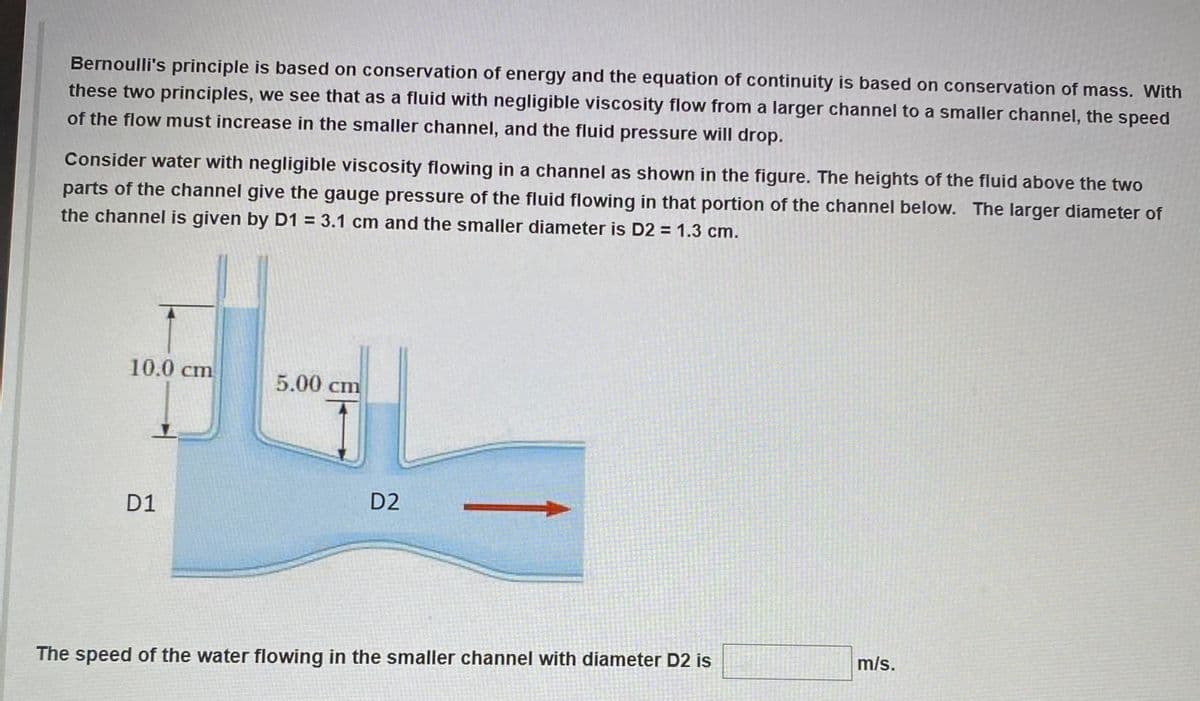Bernoulli's principle is based on conservation of energy and the equation of continuity is based on conservation of mass. With these two principles, we see that as a fluid with negligible viscosity flow from a larger channel to a smaller channel, the speed of the flow must increase in the smaller channel, and the fluid pressure will drop. Consider water with negligible viscosity flowing in a channel as shown in the figure. The heights of the fluid above the two parts of the channel give the gauge pressure of the fluid flowing in that portion of the channel below. The larger diameter of the channel is given by D1 = 3.1 cm and the smaller diameter is D2 = 1.3 cm. 10.0 cm 5.00 cm D1 D2 | m/s. The speed of the water flowing in the smaller channel with diameter D2 is
Bernoulli's principle is based on conservation of energy and the equation of continuity is based on conservation of mass. With these two principles, we see that as a fluid with negligible viscosity flow from a larger channel to a smaller channel, the speed of the flow must increase in the smaller channel, and the fluid pressure will drop. Consider water with negligible viscosity flowing in a channel as shown in the figure. The heights of the fluid above the two parts of the channel give the gauge pressure of the fluid flowing in that portion of the channel below. The larger diameter of the channel is given by D1 = 3.1 cm and the smaller diameter is D2 = 1.3 cm. 10.0 cm 5.00 cm D1 D2 | m/s. The speed of the water flowing in the smaller channel with diameter D2 is
University Physics Volume 1
18th Edition
ISBN:9781938168277
Author:William Moebs, Samuel J. Ling, Jeff Sanny
Publisher:William Moebs, Samuel J. Ling, Jeff Sanny
Chapter14: Fluid Mechanics
Section: Chapter Questions
Problem 67P: Archimedes' principle can be used to calculate the density of a fluid as well as that of a solid....
Related questions
Question
100%
Can someone please help with question 13. Will give thumbs up

Transcribed Image Text:Bernoulli's principle is based on conservation of energy and the equation of continuity is based on conservation of mass. With
these two principles, we see that as a fluid with negligible viscosity flow from a larger channel to a smaller channel, the speed
of the flow must increase in the smaller channel, and the fluid pressure will drop.
Consider water with negligible viscosity flowing in a channel as shown in the figure. The heights of the fluid above the two
parts of the channel give the gauge pressure of the fluid flowing in that portion of the channel below. The larger diameter of
the channel is given by D1 = 3.1 cm and the smaller diameter is D2 = 1.3 cm.
10.0 cm
5.00 cm
D1
D2
m/s.
The speed of the water flowing in the smaller channel with diameter D2 is
Expert Solution
This question has been solved!
Explore an expertly crafted, step-by-step solution for a thorough understanding of key concepts.
Step by step
Solved in 3 steps

Knowledge Booster
Learn more about
Need a deep-dive on the concept behind this application? Look no further. Learn more about this topic, physics and related others by exploring similar questions and additional content below.Recommended textbooks for you

University Physics Volume 1
Physics
ISBN:
9781938168277
Author:
William Moebs, Samuel J. Ling, Jeff Sanny
Publisher:
OpenStax - Rice University

College Physics
Physics
ISBN:
9781938168000
Author:
Paul Peter Urone, Roger Hinrichs
Publisher:
OpenStax College

Principles of Physics: A Calculus-Based Text
Physics
ISBN:
9781133104261
Author:
Raymond A. Serway, John W. Jewett
Publisher:
Cengage Learning

University Physics Volume 1
Physics
ISBN:
9781938168277
Author:
William Moebs, Samuel J. Ling, Jeff Sanny
Publisher:
OpenStax - Rice University

College Physics
Physics
ISBN:
9781938168000
Author:
Paul Peter Urone, Roger Hinrichs
Publisher:
OpenStax College

Principles of Physics: A Calculus-Based Text
Physics
ISBN:
9781133104261
Author:
Raymond A. Serway, John W. Jewett
Publisher:
Cengage Learning

Physics for Scientists and Engineers: Foundations…
Physics
ISBN:
9781133939146
Author:
Katz, Debora M.
Publisher:
Cengage Learning

Physics for Scientists and Engineers, Technology …
Physics
ISBN:
9781305116399
Author:
Raymond A. Serway, John W. Jewett
Publisher:
Cengage Learning

Glencoe Physics: Principles and Problems, Student…
Physics
ISBN:
9780078807213
Author:
Paul W. Zitzewitz
Publisher:
Glencoe/McGraw-Hill